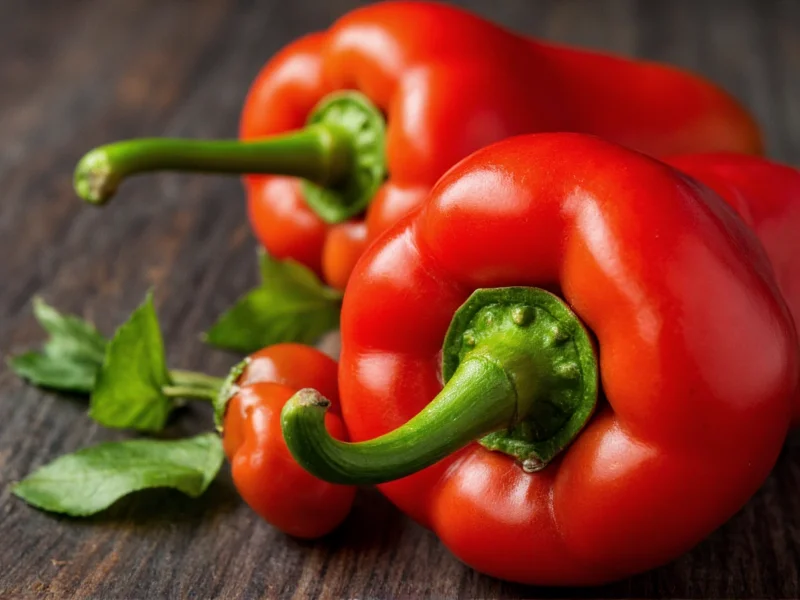Serrano peppers are a staple in Mexican cuisine, prized for their bright, grassy flavor and distinctive heat. Understanding their spiciness level helps home cooks and professional chefs alike use them effectively in recipes without overwhelming other flavors. Unlike some chili peppers that focus solely on heat, serranos offer a complex flavor profile that enhances dishes while providing a noticeable kick.
Understanding Serrano Pepper Heat Levels
The Scoville scale measures chili pepper heat by determining capsaicin concentration. Serrano peppers land firmly in the medium-to-hot range at 10,000-23,000 SHU. To put this in perspective, a bell pepper registers 0 SHU while the Carolina Reaper can exceed 2,000,000 SHU. Serranos consistently outpace jalapeños (2,500-8,000 SHU) but fall well short of habaneros (100,000-350,000 SHU).
Several factors influence serrano pepper spiciness:
- Growing conditions: Stressors like inconsistent watering or nutrient deficiencies can increase capsaicin production
- Maturity: Red serranos (fully mature) are typically hotter than green ones
- Individual variation: Even peppers from the same plant can vary in heat
- Part of the pepper: The placenta (white ribs) contains the highest concentration of capsaicin
Comparing Serrano Peppers to Other Common Varieties
| Pepper Variety | Scoville Heat Units | Heat Comparison to Serrano | Flavor Profile |
|---|---|---|---|
| Serrano | 10,000-23,000 | Baseline | Bright, grassy, slightly floral |
| Jalapeño | 2,500-8,000 | 2-5x milder | Grassy, slightly sweet |
| Cayenne | 30,000-50,000 | 1.5-3x hotter | Sharp, slightly smoky |
| Habanero | 100,000-350,000 | 5-15x hotter | Fruity, citrusy, floral |
| Thai Bird's Eye | 50,000-100,000 | 3-8x hotter | Sharp, pungent |
Flavor Profile Beyond the Heat
While serrano peppers deliver noticeable heat, their flavor profile makes them particularly valuable in cooking. They offer a clean, bright, grassy taste with subtle citrus notes that distinguish them from jalapeños' earthier profile. This complex flavor means serranos enhance dishes rather than merely adding heat. When cooked, they develop slightly sweet undertones while maintaining their characteristic kick.
The thinner walls of serrano peppers compared to jalapeños mean they distribute heat more evenly in sauces and salsas. Their smaller size (typically 1-3 inches long) makes them ideal for chopping finely without overwhelming other ingredients.
Practical Culinary Applications
Serrano peppers shine in fresh preparations where their bright flavor can be appreciated:
- Salsas and pico de gallo: Finely diced serranos add heat without dominating other ingredients
- Guacamole: A small amount enhances traditional avocado dip
- Marinades: Blended with citrus juices for meats and vegetables
- Vinegar infusions: Creates flavorful hot sauce base
- Garnishes: Thin slices add visual appeal and controlled heat
When cooking with serranos, remember that heat distribution varies throughout the pepper. The seeds and white ribs contain the highest capsaicin concentration, so removing these reduces heat significantly while preserving flavor. For consistent results in recipes, taste a small piece before adding the entire pepper.
Safety and Handling Considerations
Working with serrano peppers requires proper handling to avoid discomfort:
- Always wear gloves when handling hot peppers, especially when cutting multiple peppers
- Avoid touching your face, particularly eyes, during and after handling
- Wash hands thoroughly with soap and water after handling (alcohol-based sanitizers can spread capsaicin)
- If experiencing skin irritation, apply milk or yogurt to affected areas
- Never rub eyes after handling hot peppers—even residual oils can cause significant discomfort
Substitutes When Serranos Aren't Available
If you can't find serrano peppers, consider these alternatives based on your heat preference:
- For similar heat: Fresh green Thai chilies (use half the amount) or a combination of jalapeño with a pinch of cayenne
- For milder option: Jalapeños (use 1.5-2 times the amount of serrano called for)
- For hotter option: Red serranos or fresh cayenne peppers (use half the amount)
- Dried alternative: Chipotle peppers in adobo sauce (reconstituted) for smoky depth with moderate heat
When substituting, always taste as you go—pepper heat varies significantly even within the same variety. Remember that cooking concentrates flavors, so add hot peppers gradually to avoid making a dish inedibly spicy.
Troubleshooting Serrano Pepper Heat Issues
If your serrano peppers seem less spicy than expected, several factors could be at play:
- Growing conditions: Consistently ideal growing conditions produce milder peppers
- Harvest timing: Peppers picked early (green stage) are typically milder
- Water content: Higher water content dilutes capsaicin concentration
- Soil composition: Nutrient-rich soil can produce less spicy peppers
Conversely, if your serranos are unexpectedly hot, they may have experienced stress during growth (inconsistent watering, temperature extremes, or nutrient deficiencies), which increases capsaicin production as a defense mechanism.











 浙公网安备
33010002000092号
浙公网安备
33010002000092号 浙B2-20120091-4
浙B2-20120091-4